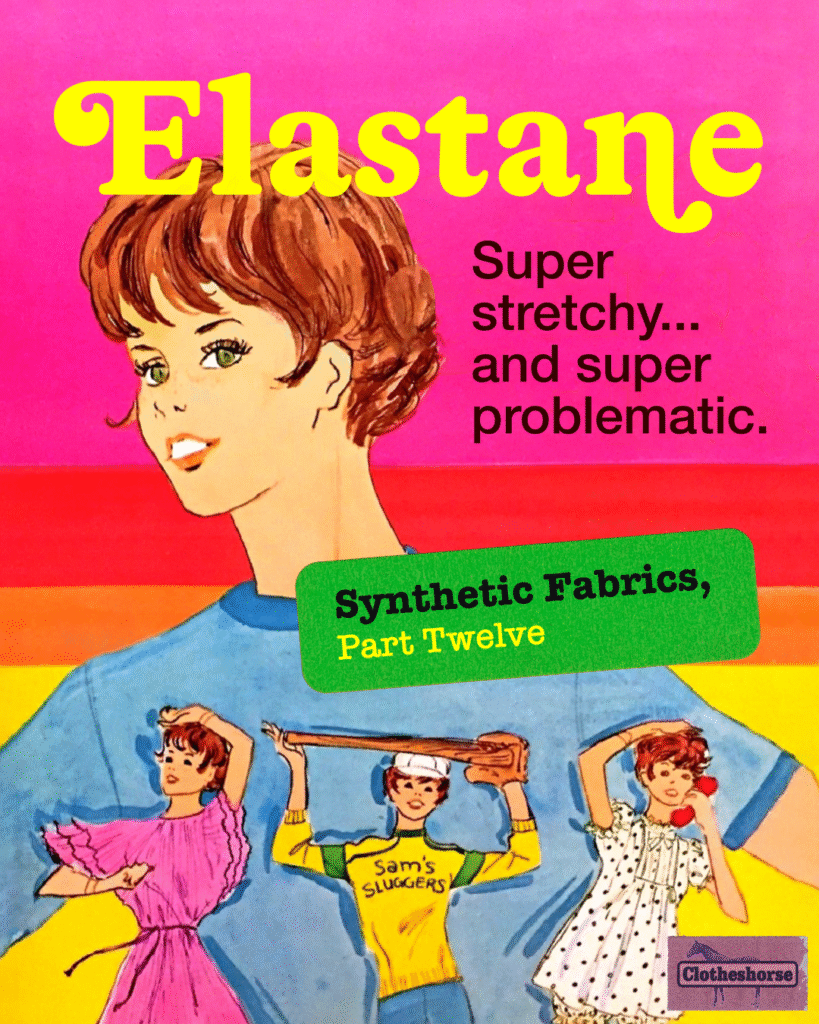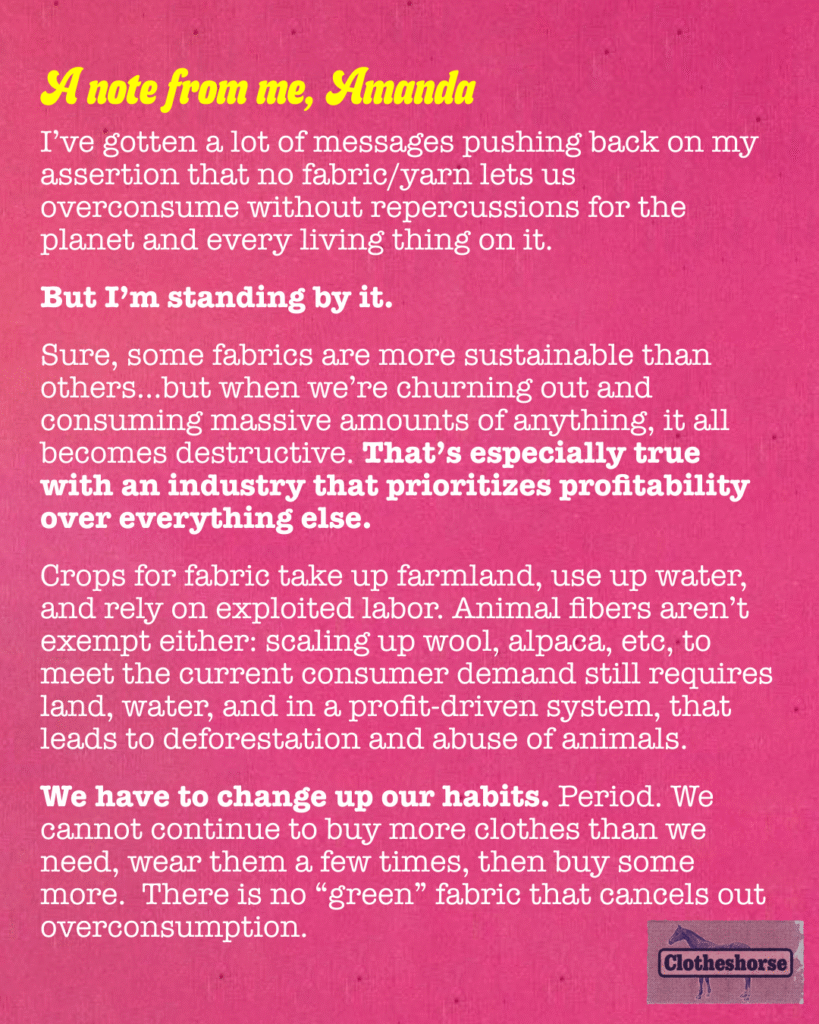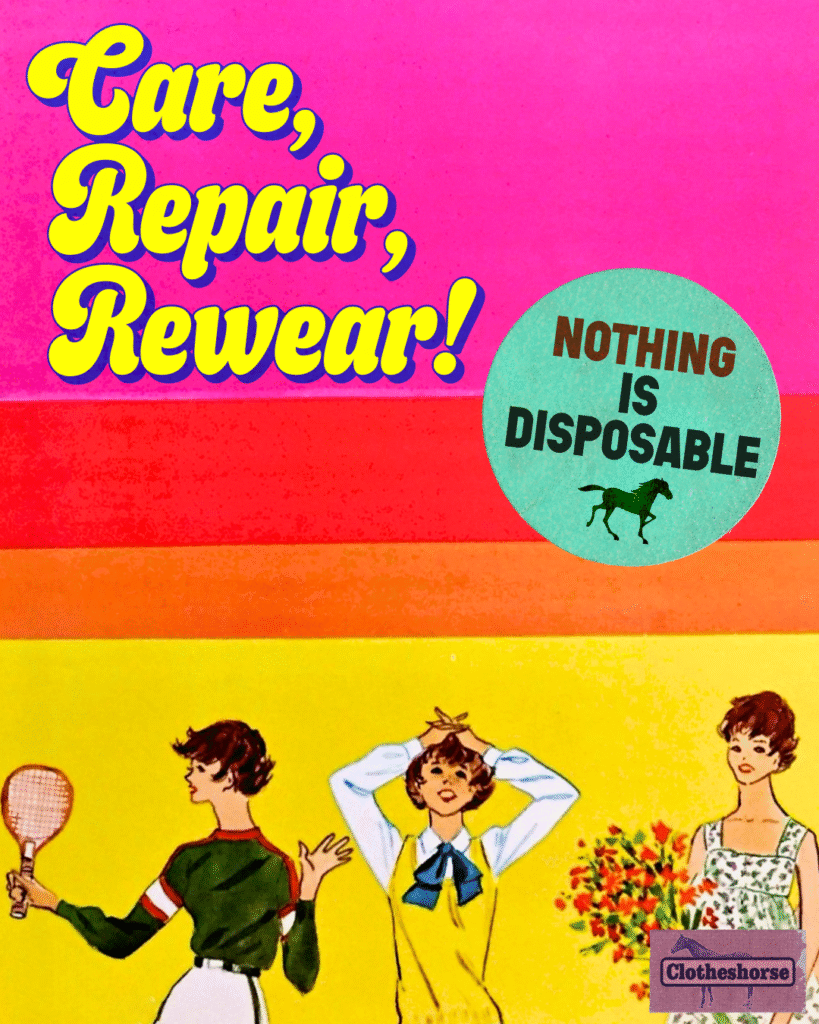
Queue the Boys II Men…because this is the final post in my series about synthetic fabrics. And for this final post, we’re going to talk about a banger: elastane aka spandex aka Lycra.
Elastane is in so many of the clothes we are being sold these days: jeans, underwear, shapewear, swimsuits, socks, leggings, tees. But guess what? It’s plastic. Fossil fuel-derived. High carbon footprint to produce. Not recyclable. Not biodegradable. And the second it stretches out… it’s trash.
The fashion industry has begun to add a little bit of elastane to so many of our clothes because it makes things fit a little bit better…without investing the time and money to make it fit better. It can lower return rates for difficult categories like jeans. In a fast fashion, online shopping kinda world…it makes sense to make all clothes a little stretchy. But when the fibers stop recovering their stretch after each wear, the clothes themselves become unwearable. Jeggings start falling down all day. Leggings get weird and baggy in the knees. Shirts fit weird. And sports bras stop doing their job.
But also: in some cases there just aren’t that many good alternatives to plain old spandex, like sports bras and swimwear. Like, I just wear cotton pants and a t-shirt to work out, but I kinda need a sports bra for anything serious. So I get it!
In this post, we’re digging into what elastane is, how it’s made, why it’s in everything, and how to care for it so it doesn’t hit the landfill quite so fast.
Elastane is a generic name for an entire family of stretchy fabrics. It is also called spandex. One “name brand” version of elastane is Lycra.
Elastane is an entirely synthetic fabric.
That means it is made from petroleum.
The process for manufacturing it is energy intensive, so elastane has a high carbon footprint.
And because it is synthetic, it is not biodegradable. It is also not recyclable.
It also contributes to microplastic pollution.
Jeans + jeggings: helps them fit snugly
Tees + tops: gives subtle stretch
Bras, underwear, + shapewear: adds support and flexibility
Swimwear: often blended with nylon
Socks + tights: helps them stay in place
Leggings + sports bras: stretch gives maximum movement
Bodycon dresses + skirts: basically any fitted garment
Also: compression garments, braces, bandages, some uniforms, and dancewear
Elastane is used in so many items…many times you won’t be able to tell unless you read the fiber content label.
Sometimes it is almost “invisibly” blended at just 1-3% of the total fiber content…enough to make the garment fit a certain way (or make the fit just a little easier).
In fact, the addition of elastane to just about everything is part of the fast fashion-ification of clothing: adding a tiny bit of stretch means that the fit doesn’t have to be perfect, which saves the time/$$$ usually needed to get it right.
Stretches up to 500%…and then bounces back (until it loses that ability over time).
Cannot regain its stretchiness after it loses it.
Not breathable, not recyclable, not biodegradable.
Sheds microplastics every time you wear or wash it.
Breaks down over time with exposure to heat, chlorine, your body’s natural oils, and general wear.
Fossil fuels (petroleum) are used to create a polyurethane polymer. You might remember polyurethane (PU) from the installment in this series about fake leather.
These PU polymers are mixed with solvents to create a stretchy plastic goo.
Next, fibers are created by pushing the goo through tiny holes (a spinneret) and blasting it with hot air.
These fibers are stretched to several times their original length. This gives elastane its stretch and recovery. The fibers are then heat-treated to “set” that stretchiness.
At this point, the fibers may be coated with a lubricant like silicone to make it easier to mix with other fibers.
Unlike some plastics, elastane just cannot be melted down or reused. Period.
What makes this even more depressing? When elastane is blended with other fabrics (and we know it’s in so many clothes these days), those fabrics can no longer be recycled either. The tech to separate these fibers just doesn’t exist yet.
In fact, even a tiny bit of elastane can clog mechanical recycling machinery.
Basically all clothing with elastane is destined for the landfill.
The most important thing you can do to live a more sustainable, mindful way of life is…wear your clothes for as long as possible. And that means, no matter which fabrics you choose:
Pick things that make you feel comfortable (mentally and physically), so you will be more inclined to wear them over and over again. Sometimes that’s just going to mean that YES, you do own items like spandex sports bras and leggings.
Take care of your clothing to make it last as long as possible. And repair it if possible.
Don’t buy more than you need. Like, no one needs a leggings subscription (sorry, but it’s true).
In some cases…YES! But it will require thinking differently (and maybe spending a little bit more $$$). And other times, there just isn’t a better option.
For workout clothing and loungewear, consider natural fibers with built-in stretch, like knit cotton, linen jersey, or ribbed wool.
For regular comfy clothes, look for clothes made from woven fabrics using old school techniques to help you move with ease: bias cuts, gathers, darts, and pleats.
Also, think about the longevity of a garment. A fully stretchy dress? Eventually that will wear out and then it’s kinda RIP. But a woven dress with an elastic waist? You can replace that elastic when it wears out…and you still have a fully functional dress!
There are some “compostable” alternatives to spandex out there, but once again, read labels carefully and stay skeptical.
Wash in cold water on the gentle cycle (or even wash by hand). Remember, heat breaks down the elastane fibers over time, so you want to avoid hot water at all costs.
Skip the dryer! Yep, heat and elastane are not a good combo, so air dry is the way.
Rotate your wears. I know this sounds weird, but elastane needs rest to recover its stretchiness! So don’t wear the same leggings or skinny jeans three days in a row. Give them a day off!
Just say no to fabric softener. It actually coats the fibers and affects their stretchiness.
Be careful with lotions and oils. They can degrade the stretch over time.

Your list may vary (because values are extremely personal):
Amazon, Walmart, Target, SHEIN, Temu…basically any company with opaque supply chains and labor issues.
Companies like Trader Joes and Starbucks who engage in anti-union tactics.
Brands who refused to #PayUp on orders cancelled in 2020: all the URBN brands, American Eagle, Aerie, TJ Maxx, Home Goods, Marshalls, Ross, Kohl’s, Forever 21, and more.
Any company with an obvious political stance that does not fit my own values. Yeah, that means I won’t be renting a truck from the U-Haul place in my town with a massive Trump sign. Definitely not buying cookies from this terrible viral cookie place here in Lancaster County.
That’s just the beginning of my list. Most importantly, I try to shop secondhand first. And when I can’t do that, I start by looking for something local from a small business.
My thought process as I make decisions about where and when to shop:
First things first: do I really need this? Is it more of a want?
If it’s clothing: why do I need it? When and how will I wear it? Am I prepared to care for it properly and mend it when necessary?
If it’s not clothing, where will it live in my home? Can I see myself using this thing for a long time?
Can I find it secondhand? Often I’ll look online and in person for this item, for days, weeks, even months (if it is not urgent).
If I can’t find it secondhand, can I find it from a local small business? That means my money will stay within the community.
If I can’t find it locally, can I find it elsewhere from a small business? My money has more immediate impact with a small business.
If I still can’t find it, but definitely need it…then I’ll buy it elsewhere.

Want a real, paper version of this series? Get your own copy of The Clotheshorse Guide to Synthetic Fibers & Fabrics here.
If you want to share your opinion/additional thoughts on the subjects we cover in each episode, feel free to email, whether it’s a typed out message or an audio recording: [email protected]
Slow Fashion Academy is a size-inclusive sewing and patternmaking studio based in Philadelphia, Pennsylvania. Designer and fashion professor Ruby Gertz teaches workshops for hobbyists and aspiring designers, so that anyone can learn the foundational skills of making, mending, and altering their own clothes. Ruby also provides professional design and patternmaking services to emerging slow fashion brands, and occasionally takes commissions for custom garments and costume pieces. She has also released several PDF sewing patterns for original designs under her brands Spokes & Stitches, and Starling Petite Plus. Check the schedule for upcoming workshops, download PDF sewing patterns, and learn about additional sewing and design services at www.slowfashion.academy.
Thumbprint is Detroit’s only fair trade marketplace, located in the historic Eastern Market. Our small business specializes in products handmade by empowered women in South Africa making a living wage creating things they love like hand painted candles and ceramics! We also carry a curated assortment of sustainable/natural locally made goods. Thumbprint is a great gift destination for both the special people in your life and for yourself! Browse our online store at thumbprintdetroit.com and find us on instagram @thumbprintdetroit.
Picnicwear: a slow fashion brand, ethically made by hand from vintage and deadstock materials – most notably, vintage towels! Founder, Dani, has worked in the industry as a fashion designer for over 10 years, but started Picnicwear in response to her dissatisfaction with the industry’s shortcomings. Picnicwear recently moved to rural North Carolina where all their clothing and accessories are now designed and cut, but the majority of their sewing is done by skilled garment workers in NYC. Their customers take comfort in knowing that all their sewists are paid well above NYC minimum wage. Picnicwear offers minimal waste and maximum authenticity: Future Vintage over future garbage.
Shift Clothing, out of beautiful Astoria, Oregon, with a focus on natural fibers, simple hardworking designs, and putting fat people first. Discover more at shiftwheeler.com
High Energy Vintage is a fun and funky vintage shop located in Somerville, MA, just a few minutes away from downtown Boston. They offer a highly curated selection of bright and colorful clothing and accessories from the 1940s-1990s for people of all genders. Husband-and-wife duo Wiley & Jessamy handpick each piece for quality and style, with a focus on pieces that transcend trends and will find a home in your closet for many years to come! In addition to clothing, the shop also features a large selection of vintage vinyl and old school video games. Find them on instagram @ highenergyvintage, online at highenergyvintage.com, and at markets in and around Boston.
St. Evens is an NYC-based vintage shop that is dedicated to bringing you those special pieces you’ll reach for again and again. More than just a store, St. Evens is dedicated to sharing the stories and history behind the garments. 10% of all sales are donated to a different charitable organization each month. New vintage is released every Thursday at wearStEvens.com, with previews of new pieces and more brought to you on Instagram at @wear_st.evens.
Deco Denim is a startup based out of San Francisco, selling clothing and accessories that are sustainable, gender fluid, size inclusive and high quality–made to last for years to come. Deco Denim is trying to change the way you think about buying clothes. Founder Sarah Mattes wants to empower people to ask important questions like, “Where was this made? Was this garment made ethically? Is this fabric made of plastic? Can this garment be upcycled and if not, can it be recycled?” Signup at decodenim.com to receive $20 off your first purchase. They promise not to spam you and send out no more than 3 emails a month, with 2 of them surrounding education or a personal note from the Founder. Find them on Instagram as @deco.denim.
The Pewter Thimble Is there a little bit of Italy in your soul? Are you an enthusiast of pre-loved decor and accessories? Bring vintage Italian style — and history — into your space with The Pewter Thimble (@thepewterthimble). We source useful and beautiful things, and mend them where needed. We also find gorgeous illustrations, and make them print-worthy. Tarot cards, tea towels and handpicked treasures, available to you from the comfort of your own home. Responsibly sourced from across Rome, lovingly renewed by fairly paid artists and artisans, with something for every budget. Discover more at thepewterthimble.com
Blank Cass, or Blanket Coats by Cass, is focused on restoring, renewing, and reviving the history held within vintage and heirloom textiles. By embodying and transferring the love, craft, and energy that is original to each vintage textile into a new garment, I hope we can reteach ourselves to care for and mend what we have and make it last. Blank Cass lives on Instagram @blank_cass and a website will be launched soon at blankcass.com.
Vagabond Vintage DTLV is a vintage clothing, accessories & decor reselling business based in Downtown Las Vegas. Not only do we sell in Las Vegas, but we are also located throughout resale markets in San Francisco as well as at a curated boutique called Lux and Ivy located in Indianapolis, Indiana. Jessica, the founder & owner of Vagabond Vintage DTLV, recently opened the first IRL location located in the Arts District of Downtown Las Vegas on August 5th. The shop has a strong emphasis on 60s & 70s garments, single stitch tee shirts & dreamy loungewear. Follow them on instagram, @vagabondvintage.dtlv and keep an eye out for their website coming fall of 2022.
Country Feedback is a mom & pop record shop in Tarboro, North Carolina. They specialize in used rock, country, and soul and offer affordable vintage clothing and housewares. Do you have used records you want to sell? Country Feedback wants to buy them! Find us on Instagram @countryfeedbackvintageandvinyl or head downeast and visit our brick and mortar. All are welcome at this inclusive and family-friendly record shop in the country!
Located in Whistler, Canada, Velvet Underground is a “velvet jungle” full of vintage and second-hand clothes, plants, a vegan cafe and lots of rad products from other small sustainable businesses. Our mission is to create a brand and community dedicated to promoting self-expression, as well as educating and inspiring a more sustainable and conscious lifestyle both for the people and the planet. Find us on Instagram @shop_velvetunderground or online at www.shopvelvetunderground.com
Selina Sanders, a social impact brand that specializes in up-cycled clothing, using only reclaimed, vintage or thrifted materials: from tea towels, linens, blankets and quilts. Sustainably crafted in Los Angeles, each piece is designed to last in one’s closet for generations to come. Maximum Style; Minimal Carbon Footprint.
Salt Hats: purveyors of truly sustainable hats. Hand blocked, sewn and embellished in Detroit, Michigan.
Republica Unicornia Yarns: Hand-Dyed Yarn and notions for the color-obsessed. Made with love and some swearing in fabulous Atlanta, Georgia by Head Yarn Wench Kathleen. Get ready for rainbows with a side of Giving A Damn! Republica Unicornia is all about making your own magic using small-batch, responsibly sourced, hand-dyed yarns and thoughtfully made notions. Slow fashion all the way down and discover the joy of creating your very own beautiful hand knit, crocheted, or woven pieces. Find us on Instagram @republica_unicornia_yarns and at www.republicaunicornia.com.
Cute Little Ruin is an online shop dedicated to providing quality vintage and secondhand clothing, vinyl, and home items in a wide range of styles and price points. If it’s ethical and legal, we try to find a new home for it! Vintage style with progressive values. Find us on Instagram at @CuteLittleRuin.